Can Tattoos Be Medicinal?
In his travels around the world, anthropologist Lars Krutak has seen many tribal tattoos, including some applied to relieve specific ailments
/https://tf-cmsv2-smithsonianmag-media.s3.amazonaws.com/filer/20121210111008Kayan-tattoo-web.jpg)
“The earliest evidence we have of tattoos, not surprisingly, is cosmetic,” says Lars Krutak. Tattooed on the upper lip of a 7,000-year-old mummy from the Chinchorro culture of northern Chile and southern Peru is a thin pencil mustache. “But, the second oldest we have is medicinal,” he adds.
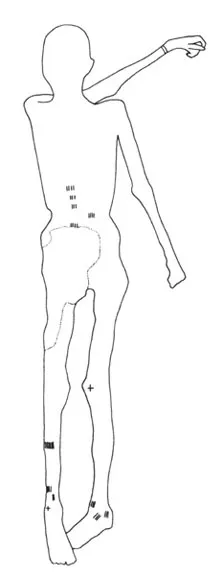
Krutak, sitting at his desk in the bowels of the National Museum of Natural History, is referring to Ötzi, the 5,300-year-old mummified “Iceman,” so named by researchers because he was discovered in the Ötztal Alps on the Italy-Austria border in September 1991. The preserved body has a total of 57 tattoos—short lines etched in groups on his lower back and ankles, a cross behind his right knee and two rings around his left wrist.
“Incredibly, approximately 80 percent of these tattoos overlap with classical Chinese acupuncture points utilized to treat rheumatism, a medical condition that plagued the Iceman. Other tattoos were found to be located on or near acupuncture meridians that may have had the purpose of relieving other ailments, like gastro-intestinal problems,” writes Krutak in his latest book, Spiritual Skin: Magical Tattoos and Scarification, published this fall. The Iceman had a whipworm infection, researchers discovered in 2001.
Krutak works as a repatriation case officer in the museum’s anthropology department, returning human remains, funerary objects and sacred and ceremonial objects to Native tribes in Alaska. But, in addition to these duties, he is an expert in the anthropology of tattoos. As an undergraduate at the University of Colorado, Boulder in the early 1990s, Krutak studied art history and anthropology. “Those two things have always been a passion of mine, and tattooing is one way for me to connect both of them together,” he says. In 1998, he received a master’s degree in anthropology from the University of Alaska, Fairbanks, and, by 2009, he had earned a doctorate in the discipline from Arizona State University.
Krutak’s introduction to tattoos happened during his graduate school years. For his master’s thesis, he studied a traditional tattoo technique called skin-stitching, performed by the Yupiget women on St. Lawrence Island off the coast of Alaska in the Bering Sea. Skin-stitching is literally sewing geometric designs into the skin; Krutak calls it “epidermal embroidery.” Through interviewing the last remaining women who still practice the art, he also learned that the St. Lawrence Island Yupiget had historically used a therapeutic tattoo method that resembled the joint markings on the Iceman. “It’s a form of tattoo puncture, or acupuncture but leaving behind a pigment,” says Krutak. The residue was thought to be “a magical pigment believed to shut down passageways into the souls of the body,” he explains.
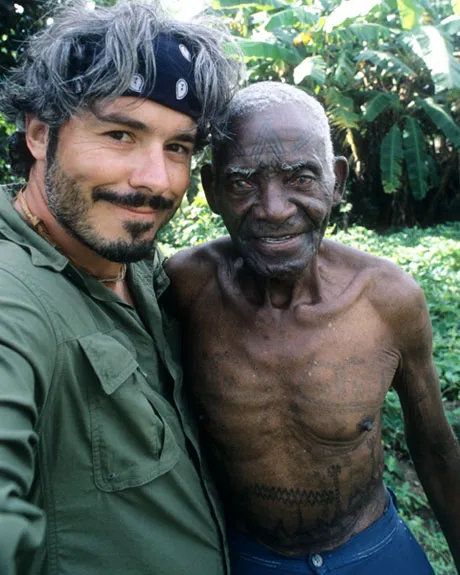
Since this first exposure, Krutak has felt an urgency to study other tribal tattoo and scarification traditions. He feels it is a race against time to get to indigenous communities in remote places across the world before these last tattoo artists and their oral histories—along with their traditional medical techniques—vanish.
Tattooing is “part of our world’s cultural and artistic heritage,” Krutak says. Maybe it is a by-product of his day job, but Krutak strongly believes that in a world where tattooing has become a multi-billion dollar industry, we should be recognizing and honoring the art form’s roots. To communicate the knowledge he gathers, the cultural anthropologist has published several books, filled with photographs that showcase the artistic ability of individuals who create intricate tattoos with natural inks and tools, such as thorns and sharpened bamboo sticks.
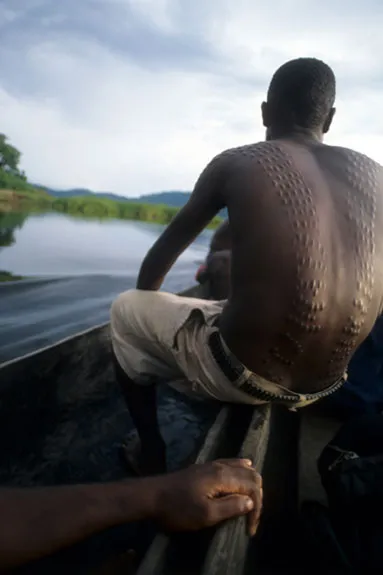
Though only one dark dot on the back of his hand is visible when he is dressed in business attire, Krutak has transformed his own body into a canvas depicting the many tribal tattoo techniques he has studied. He has been hand-tapped by the Iban people of Borneo with needles, the Kalinga of the Philippines with thorns and the Mentawai of Indonesia with nails. He has been poked by Buddhist monks in Thailand and pricked by the Kayabi of the Brazilian Amazon with palm thorns. Then, there is the skin-stitching and scarification: Krutak has received more than 100 skin-stitched tattoos and about 1,000 scars, the remnants of incisions made with razors, blades and knives.
Such experiences “help me in some sense when I’m writing and trying to understand what they mean for the peoples who created them,” explains Krutak. “Obviously, I can never be a member of these tribes just because I get a tattoo. But, it gives me some sense of the transformation that takes place.”
Oh, he adds, “And the pain, for sure.”
While filming Tattoo Hunter, a 10-part Discovery Channel series that aired in 2009 and 2010, Krutak took part in a “crocodile cutting” ceremony with the Kaningara of Papua New Guinea. A rite of passage for Kaningara boys becoming men, the ceremony involves an elder cutting a massive pattern of small incisions on a participant’s chest and back. “After 450 plus cuts, my entire chest felt like it was on fire,” writes Krutak in Spiritual Skin. (If you don’t believe him, watch him bear the pain in this episode capturing the process.) River mud is applied to the fresh cuts, which causes them to become infected. The overall effect—in both look and touch—is reminiscent of the scales on a crocodile. The Kaningara believe that with this scarification they appropriate the powers and knowledge of the crocodile spirit.
So certainly tattoos have a spiritual tradition. But medicinal?
Colin Dale, a tattooist in Copenhagen, Denmark, has mastered several traditional forms of tattooing. He has personally sewn all of Krutak’s skin-stitches and shares the anthropologist’s interest in medicinal tattoos. Last year, in fact, for the 20th anniversary of the Iceman’s discovery, Dale conducted a small test, tattooing David Schütze, a client plagued by asthma, rheumatism in several of his joints, headaches, tinnitus in his ear and a loud snoring habit, with marks similar to Ötzi’s and in many of the same spots. Dale had an acupuncturist on hand to recommend locations that aligned with certain acupuncture points. After three months time, Schütze reported that just about all of his pains and symptoms had noticeably eased, if not completely disappeared. By a year, some had returned, but nowhere near the original intensity. The acupuncturist, Irg Bernhardt, compared the results of the one tattooing session to 10 to 15 acupuncture treatments. “In my estimation, this project shows that tattooing of acupuncture points a sustained therapeutic effect,” said Bernhardt in Spiritual Skin. “And not just for a short period of time, since it actually seems to work for the long term.”
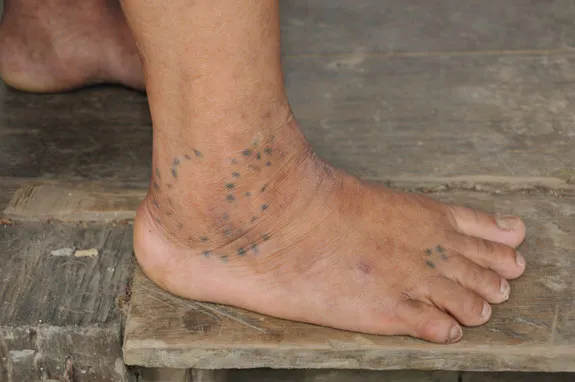
Besides the St. Lawrence Island Yupiget women, Krutak has found two other groups that continue to practice therapeutic joint tattooing 5,300 years after the Iceman lived. Last spring, in Borneo, he met some Kayan men and women who had dots tattooed on their wrists, ankles and knee caps. When he asked about the tattoos, the Kayan explained that whenever they sprained a joint, one woman in their clan would tattoo dots on the swollen area and full mobility would typically return within a week. Krutak noticed that some of the people who had experienced multiple sprains had layers of tattooing. (Actually, Krutak and others believe that the Iceman’s tattoos may have been applied on several occasions, since they are so clear and dark to this day.) More recently, the anthropologist spotted joint tattooing among the Inland Aroma people of Papua New Guinea.
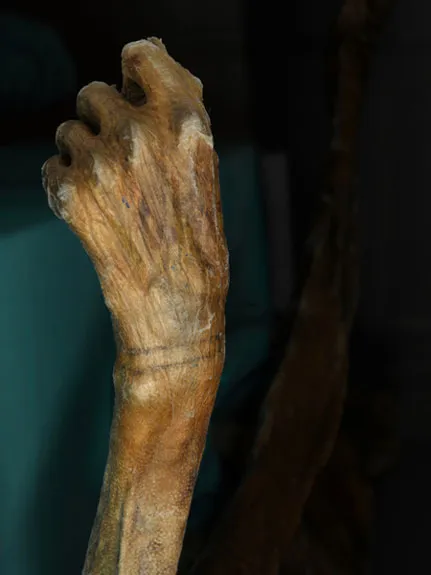
Krutak suspects that medicinal tattooing of this type arose in many places simultaneously, as opposed to diffusing from one specific location. Whether by accident or experimentation, people found tattooing to relieve their ailments, he says.
As one can imagine, there may be “many more possible relationships and connections between organs, points, joints, and tattoos that are waiting to be discovered,” Krutak notes.
/https://tf-cmsv2-smithsonianmag-media.s3.amazonaws.com/accounts/headshot/megan.png)
/https://tf-cmsv2-smithsonianmag-media.s3.amazonaws.com/accounts/headshot/megan.png)